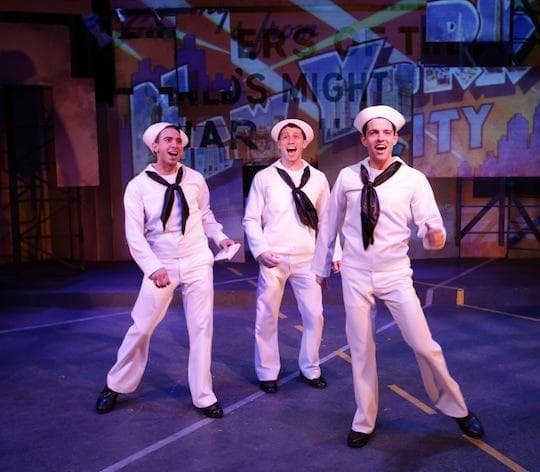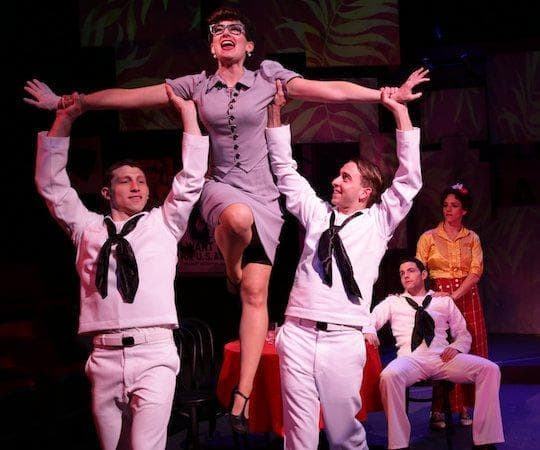Advertisement
New York, New York, It's A Muy Caliente Town

BOSTON – They probably didn’t plan it this way, but the Lyric Stage Company’s “On The Town” and SpeakEasy Stage Company’s “In The Heights” make for a very smart musical festival on assimilation, the first coming midway through the 20th century and the other ushering in the 21st. That both companies do full justice to the material makes the Town Heights affair even harder to resist.
But what does “On the Town,” a musical about three sailors of no discernible ethnicity visiting New York City have to do with Jewish assimilation? Well, just about everything.
For Leonard Bernstein and his lyricist pals Adolph Green and Betty Comden (nee Basya Cohen), the Broadway musical was a melting pot of European melody, jazz rhythms, and operetta. New York City was the place it all happened, the great meeting place between high art and populist (not merely pop) culture. New York, New York. It’s a helluva town. When you look at the three sailors on 24-hour shore leave being looked down upon by the snootier, dare we say WASPish elements of society, it’s not such a stretch to see them as stand-ins for Lenny and company looking, if not demanding, a seat at the table.
Half a century later, Lin-Manuel Miranda and book writer Quiara Alegría Hudes need no such metaphors for a neighborhood of young people trying to decide whether to stay in New York’s Washington Heights or leave the neighborhood behind and head for the Bronx and beyond.
Of course, sociology may not be the first thing on your mind watching these two enjoyable productions. “In the Heights” is more familiar to contemporary audiences, having won the 2008 Tony for best new musical. Broadway in Boston also brought a fine road version to town in 2010. It revolves around, Usnavi, whose grocery store is the nexus for the Latino community, which also features a hair salon and a taxi service. Nina is the daughter of the owners of the taxi service and is home from college, perhaps for good.
Director Paul Daigneault captures the essence of the Broadway show, thanks in large part to the performance of Diego Klock-Perez as Usnavi in the role originated by Miranda. His rapping and overall presence provide the focal point of a high-spirited, sexy production. The ensemble work — dancing as well as acting — and the musicianship are pretty much universally the same high caliber as we’ve come to expect from SpeakEasy. Hats off to the whole behind-the-scenes team as well as the actors, with a particular shout-out to costume designer Elisabetta Polito.
It does, though, feel like a miniaturization of what we saw in the Opera House a few years ago. Part of the joy of the hi-def “In the Heights” came from the panoramic street scenes, the big-band sound, the spectacular choreography. Except for Nicholas James Connell’s excellent eight-man band, the rest of it feels a little scrunched at the BCA’s Roberts Theatre (through June 16).
Ironically, that gives added mojo to those in the cast who are going to leave the neighborhood behind, whether that’s Daigneault’s intention or not.
Advertisement

“On the Town,” on the other hand, feels like a reimagining of the 1944 musical, and a brilliant one at that. Artistic director Spiro Veloudos and his go-to choreographer Ilyse (no relation to Jerome) Robbins know how to use every inch of the Lyric Stage Company of Boston (through June 8). The entrances and exits of his expert assemblage of singers and dancers, just as in last season’s “Avenue Q,” which just took home a slew of Elliot Norton awards, make for a fast-paced tour of post-World War II America.
This one captures the buoyancy of most great musicals and “On the Town,” if it doesn’t reach the heights of “West Side Story” and “Candide,” is great on its own terms and this may be the most enjoyable production I’ve seen. I thought George C. Wolfe’s Public Theater production was underrated, but it was severely hampered by a set design that dwarfed the actors. Here, the Lyric’s intimacy works for the production — nthe emotional weight of their heartbreaks and triumphs feels like ours. “Adorable” isn’t an oft-used word in critical jargon, but the teamwork of all concerned make for an adorable experience at every turn.
There is a star, though — Aimee Doherty is the triple-threat singer-dancer-hoofer and if you don’t brush a tear away during her solo part in “Some Other Time,” then I’ve got no time for you. She’s Claire, who puts her snobbish fiancé aside to go off with Ozzie, the “cave man” of the sailing trio. (Comden and Green were the original Claire and Ozzie.) No one else has as much personality in their pipes as Doherty, though I wouldn’t be surprised if John Ambrosino’s solos as Gabey – “Lonely Town” and “Lucky To Be Me” get more rounded as the run progresses. They’re quite good as it is and one thing about all the singing – it’s unmiked. What a pleasure it is to hear the unamplified voice in a musical.
The acting and dancing are delightful all around, though — Robbins is quite a good actor as well as dancer and choreographer. If there’s a criticism of the show it’s that Maurice Parent didn’t get a bigger part than as an ensemble member.
Veloudos, though, does a superb job of thrusting us back into that world of three young geniuses out on a mission to make the world take note of their jazzier ways without losing sight of their Jewishness. (Listen to the klezmer sounds in Jonathan Goldberg’s brass-ish band.) Similarly, Miranda made Broadway listen, and loosen, up to how rap and uptempo Latino music are parts of our modern musical language.
I do think it’s not a positive development, though, for one person to write both the music and lyrics, as Miranda does. It allows for too much boiler-plate midtempo music and while he certainly knows how to rhyme in rap rhythm, some of his rhyming in more melodic songs doesn’t work.
That said, the two musicals and the two productions make a real statement on assimilation, then and now. And a statement on the talent of the Boston musical theater community.
This program aired on May 15, 2013. The audio for this program is not available.

